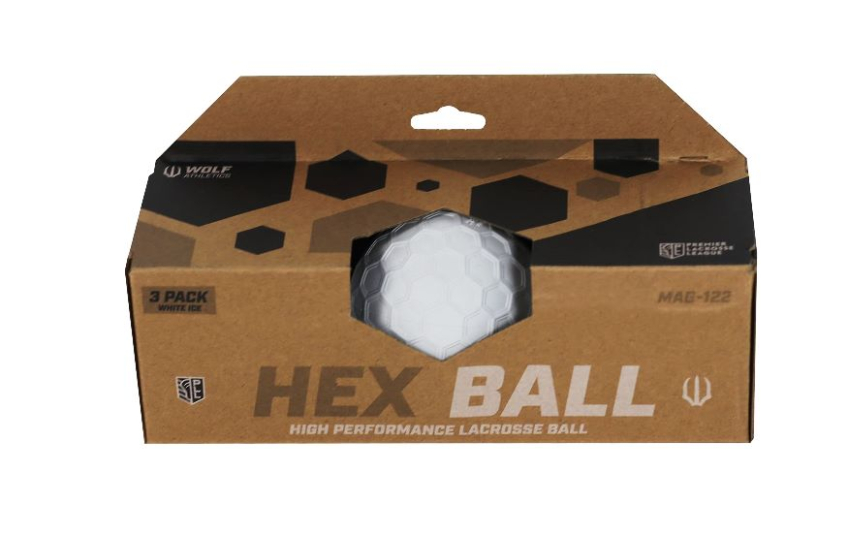Lacrosse in the United States of America and worldwide in countries like England, Australia, and others has become more popular over the last ten years. In fact, it is the fastest-growing sport in the US among kids, high schoolers, and college kids. With this growing popularity comes the stores like Dick’s, Academy, Target, and Walmart, and even I see now lacrosse shops opening up that sell just lacrosse stuff, which would have gone out of business years ago. With this, packaging and branding had to innovate and adapt for the larger market that blew up suddenly. But first, let me tell you a few things about the beautiful game of lacrosse so that this article will make sense.
Lacrosse is a sport with an exciting history that dates back to before Europeans ever stepped foot in the United States of America. According to Jane Claydon, a writer for World Lacrosse, “Lacrosse was started by the Native American Indians and was originally known as stickball. The game was initially played in the St. Lawrence Valley area by the Algonquian tribe, and they were followed by other tribes in the eastern half of North America and around the western Great Lakes” (Clayton). It is the oldest sport in North America, which many people would assume is baseball or soccer, but those were brought in after the Europeans settled in America. Back then, unlike what you see today, they were played in the wilderness, sometimes the goals being miles apart. As you can see below, instead of the modern-day 11v11 games, they were played with many more people and were much less rule-oriented.
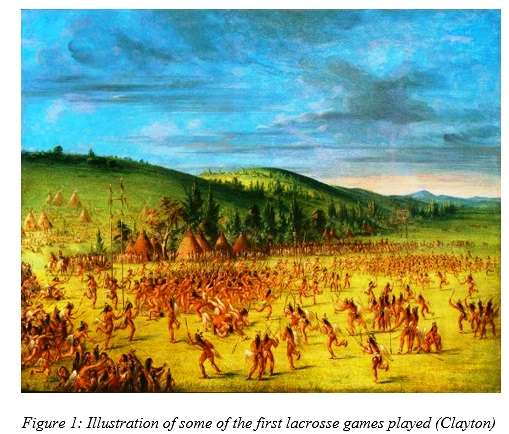
The games were much simpler back then with two rules: Do not let the ball touch the ground without using your hands, and no boundaries. When the settlers arrived, the game was first named lacrosse and was more prevalent in Canada. Then, the game became more modernized, rules changed, and lacrosse became the game we know and love today.
The game's objective is straightforward: Score more goals than the other team to win. It is a lot like hockey, but there are more players on the field, it is played on grass, it is not a puck, but a ball, the sticks have little nets on the end, and there is more scoring due to the bigger goals. The reason I say it is like hockey is that the contact that happens is a lot like hockey, with big body hits, and slaps with the stick (which hurts a lot, I will tell you from experience), so the game needs pads (Note, this for men's lacrosse, because women's lacrosse is a lot less physical with the women only wearing goggles and a mouthpiece). For these pads, they need packaging to be able to appeal to the new and growing market. Men's lacrosse players need pads for hands, elbows, chest, and a helmet (this is the minimum). So, for people these days with the market and parents not being able to afford much, this sounds like a lot of money for just the pads. But lacrosse brands like STX, Warrior, and Brine have put out very cheap starter sets of pads for kids at a lower price so that people can afford to play the game. Figure 2 shows one of these sets, which is bought by many and much cheaper than football pads, is shown below:
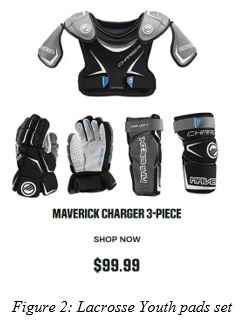
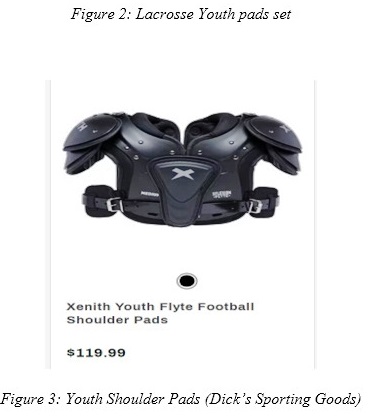
As you can see in Figures 2 and 3, the lacrosse set is $20 cheaper, with three different types of pads, as opposed to football, where there are only the shoulder pads. This was both from Dick’s website, and these lacrosse companies did these 3-in-1 sets to help the consumer so that lacrosse can keep growing. For example, one of the advantages of these sets is since the player needs all three types of pads, it makes it easier on the consumer because it is all right there. You do not have to go aisle by aisle for these things (if you do not want to spend much money). These stores are packaged in clear plastic so that the consumer knows exactly what they are getting. Also, with these kinds of things being cheap, it is not such a huge commitment as football or any other sport because kids never know what they like until they try it. So now, I will say the other parts of lacrosse gear can get expensive, like the helmet and the stick. It is tough to find a good combination of the two for less than $200. But the other thing about lacrosse is that if your kid has played soccer or football, he does not have to buy new cleats, which saves you $100. Now, for lacrosse, the packaging and branding of this stuff is super important because kids and teenagers love cool-looking stuff, and unlike other sports, a lot of your gear is customized to your liking. So, for example, lacrosse heads are unlike any other piece of equipment in sports, where it is up to the player to do what they want. I will show you Figure 3, which is a diagram of a typical lacrosse head. I will explain the components and how they are presented to the consumer, which makes it more appealing to the buyer.
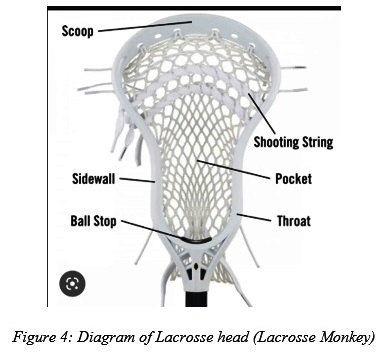
Figure 4 above shows the typical lacrosse head for someone who usually has been playing lacrosse for a while. In my experience as a lacrosse player, as kids, they always have multiple colors for their shooting string, their mesh, which is what the pocket is made of, and sometimes their shooters. For the mesh, I will show you some pictures of its packaging and tell you why it makes it unique and suitable for sale. Figures 5 and 6 are shown below.
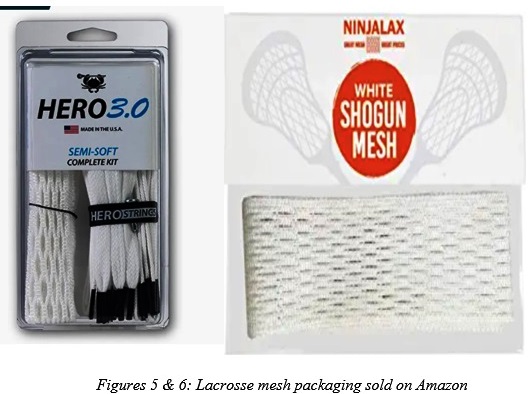
In Figure 5, the package is blister packaging with a paperboard back, and in Figure 6, the packaging is made of paper packaging. Now, I will give you a test. If you were a 10-year-old boy and had to pick one of these, even though the mesh in these packages is the same, which would you choose?
90% will pick Hero 3.0 because of the packaging and branding. Hero 3.0 stands out to you more, and the colors match well and have good contrast. Moreover, the 3.0 is made by a much more popular brand, ECD or East Coast Dyes. Also, a fun fact: lacrosse is most famous in states like Maryland, North Carolina, New York, New Jersey, and more. Also, since mesh needs to stay dry, the blister packaging most likely kept it dry while shipping to the store or home. But do you notice what both have in common? They both show you what you are getting, and for a new sport to most parents who never knew what lacrosse was, it is an asset in the packaging for lacrosse gear in general.
Now, for the stick part of the lacrosse stick, which is called the shaft. They are made from aluminum, scandium, titanium, or carbon fiber. In men’s lacrosse, there are three main types of shafts you can buy: midfield/attack, defense, and goalie shafts. Furthermore, the shortest lacrosse shaft is 30 inches or 2.5 feet, which is midfield/attack shafts, and 60 inches or 5 feet, which is the longest it can be, which d-poles use. This is a hassle for shipping cases because they are only about 1 inch in diameter and 2.5 to 5 feet long. So, they usually come in a box like the one shown below in Figure 7.
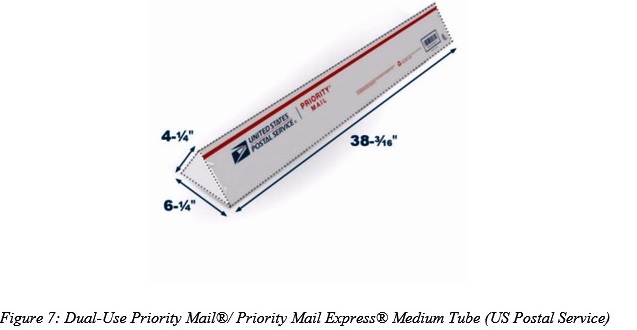
This is the ideal box for shipping these shafts to homes. The box is just a short height, and it is just long enough for the shaft. It is made out of corrugated cardboard. Also, these boxes are also made if multiple shafts need to be shipped to a store; they can be stacked in a rectangular box for optimal space saving. For the branding and display of the lacrosse shafts in stores, the shafts are displayed in a way that helps the customer buy the best one for them. For example, in all of the stores I have been to when shopping for shafts, the technique they use for display is instead of putting them in boxes like Figure 7 shows that may be clear, they are hung up in plain view where the buyer can touch, play around with, and feel the shaft in their hands so they can know the right product. Even though some consider this packaging lazy, I call it practical because if you spend $100 on something, you want to see what you’re getting, so this method helps. For the helmet, the packaging is very similar to football helmets, in which the front is shown in a rectangular box. This is shown below in Figure 8.
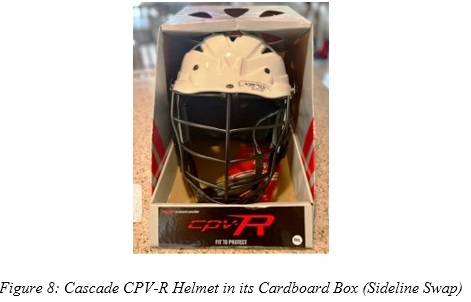
As you can see, again, the lacrosse industry does not have any questions being asked, and these companies want you to know what you are getting. This is the most expensive piece of equipment for the individual lacrosse player, the lowest being $100 and sometimes going to $300. But these helmets are high quality, so they will last you for a while, unlike a lacrosse stick or pads, which last two to three years if you take care of them. For example, shown below is a picture of me in middle school, and the helmet I am wearing lasts me through middle school and my little brother through middle school. This helmet lasted through 6 years of punishment and only cost my mom $150-$200.

Finally, lacrosse balls are the most frequent buy in the industry, made mainly by coaches. Imagine a baseball, which is about the same size as a lacrosse ball, made of either vulcanized rubber or polyurethane (. Figure 10 shows a picture of a lacrosse ball cut in half, and Figure 10 shows how lacrosse balls are usually packaged.
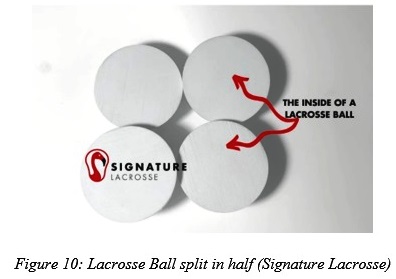
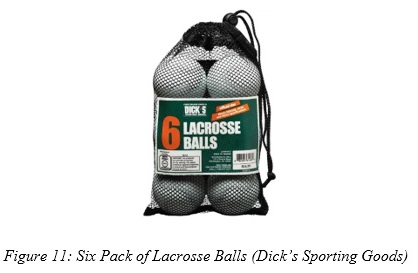
Figure 10 shows that the lacrosse ball is pure rubber, and the cost of lacrosse balls can be high with all this rubber in each ball. Figure 11 shows what most likely is a mesh bag made of nylon with a drawstring. Now, these lacrosse balls can be $4 each, which, if you are a coach and have 40 players and every other player needs a ball to pass back and forth, that is $80 right there. But what coaches mostly do, and what I did, is buy balls by the bucket, which is still super expensive, but at least you can use the bucket later when you inevitably must pick them up after practice, or else they get bad. Something like this is shown in Figure 12.
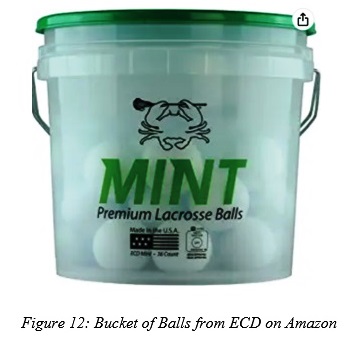
This bucket of balls, a very nice version, is almost $200 after taxes, which is expensive but will last you a while. There is a term known by lacrosse players for bad lacrosse balls, which is “greaser.” If the ball is used for a while, the outside, which for a new ball is rough rubber, the ball almost polishes and becomes slippery and unplayable. This leads to purchasing many balls, but some people degrease them, making them new again. In conclusion, the packaging for lacrosse products benefits the customer and the manufacturer alike.
References
“Amazon.com : East Coast Dyes Mint Bucket (36) Lacrosse Balls - White ...” Amazon,
https://www.amazon.com/East-Coast-Bucket-Lacrosse-Balls/dp/B07PTBH844.
Clayon, Jane. “Origin & History.” World Lacrosse, 2 Aug. 2022,
https://worldlacrosse.sport/about-world-lacrosse/origin-history/.
“Dick's Sporting Goods 6-Pack Lacrosse Balls.” Dick's Sporting Goods,
https://www.dickssportinggoods.com/p/dicks-sporting-goods-6-pack-lacrosse-balls-17dsgunnn6pklxblllxt/17dsgunnn6pklxblllxt.
“Lacrosse Head Buying Guide: Rules, Types & Specs.” Lacrosse Monkey, 26 Feb. 2020,
https://www.lacrossemonkey.com/learn/lacrosse-head-guide.
“Lacrosse Stick Length Guide & Size Chart | LacrosseMonkey.” Lacrosse Monkey, 16 Dec.
2019, https://www.lacrossemonkey.com/learn/lacrosse-stick-length-size-chart.
“New Cascade CPV-R Helmet.” SidelineSwap, https://sidelineswap.com/gear/lacrosse/lacrosse-
helmets/5021315-cascade-new-cpv-r-helmet.
“Ninjalax - Superlight Lacrosse Mesh - White – Combines the Best of ...” Amazon,
https://www.amazon.com/Ninjalax-com-Shogun-Mesh/dp/B01486VF3M.
“The Postal Store®.” USPS.com, https://store.usps.com/store/product/shipping-supplies/dual-
use-priority-mailpriority-mail-express-medium-tube---1098-P_O_1098M.
Shipping Lacrosse Sticks – Sidelineswap. 2022, https://help.sidelineswap.com/hc/en-
us/articles/360010267500-Shipping-Lacrosse-Sticks.
Signature Lacrosse. “What Is a Lacrosse Ball Made of?” Signature Lacrosse, 27 May 2020,
https://signaturelacrosse.com/blogs/news/what-is-a-lacrosse-ball-made-of.
Sports, Author Get Hyped. “Do Lacrosse Balls Have Cement in Them?” Get Hyped Sports, 7
Nov. 2019, https://gethypedsports.com/do-lacrosse-balls-have-cement-in-them/.
“What Is Blister Packaging?” VisiPak, https://www.visipak.com/what-is-blister-packaging.html.





























